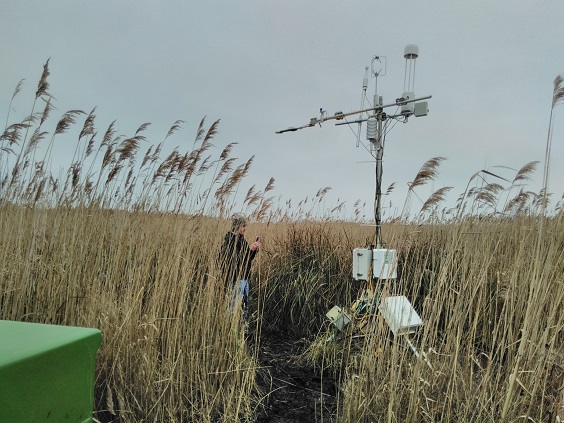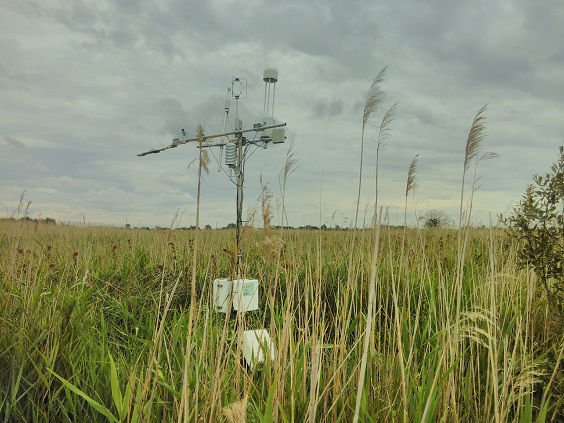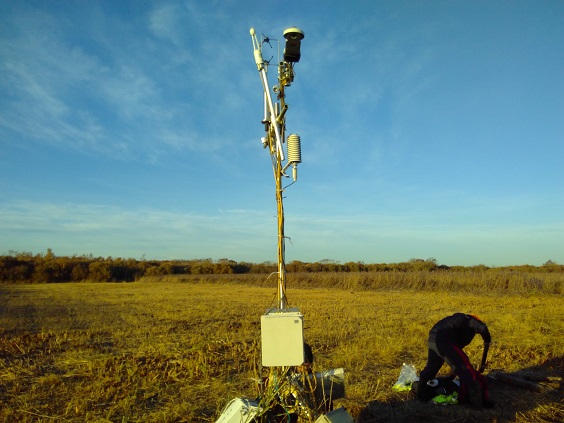I’ve been involved in setting up NCEO sensors at an important nature reserve in in the fens called Wicken Fen to measure surface temperature. These ‘in-situ’ measurements have been recorded since January 2017 and are starting to prove useful to the Surface Temperature Group at the University of Leicester for comparisons with satellite data, as part of our validation activities for satellite datasets of land surface temperature.
I enjoy going to the field site to carry out the maintenance every now and then: the landscape is so expansive, and you never know what wildlife you might see. We frequently see kestrels hovering overhead, and I once found the skin of a grass snake hidden in the sedge stems near our solar panels. This month we had a cut cable emergency.
Internationally significant wetland
Wicken Fen nature reserve, near Ely in Cambridgeshire, is owned by the National Trust. It contains a high quality open fen habitat, the Wicken Fen National Nature Reserve, which has deep peat soils that have not been drained for agriculture.
Only 0.1 per cent of the original 3,000 square kilometres Cambridgeshire Fens survive as ‘wild fen’. Hence it is one of the most important wetlands in Europe: a unique habitat of original sedge fenland, supporting thousands of plants, insects, birds and mammals. It has been designated as a Site of Special Scientific Interest, a Special Area of Conservation, and is protected by the International Convention on Wetlands of International Importance 1971 (Ramsar Convention).
The historic fen habitat is managed using traditional principles but modern techniques, with an annual work programme that includes harvesting sedge, litter cutting and scrub management. This helps iconic plant communities to thrive on the sedge fen. The newer wet meadow areas are grazed to control the growth and spread of vegetation and enable peat soils to re-establish.
Usually the tall white tripod where our sensors are mounted is only just visible above the high sedge reed beds. Sedge grows to over 2 metres high, and is like a giant grass that blows and whooshes in the wind, and can feel like a jungle to walk through.
Mown sedge and a cut cable
This summer the sedge had its first complete cut for 18 years. Unfortunately in September the sedge-cutters also cut the cable for one of our sensors, so I had to urgently fix things.
It felt really strange working in an open field of mown sedge stumps, instead of being surrounded by high sedge like a comforting green wall.
I found that the mowing patterns are visible from space – this video shows monthly composites for May to October 2018 from Planet satellite imagery at 3-metre resolution. Where a patch of sedge is mown it changes from a dark green to a brighter brown colour in the images.

University of Leicester fieldwork site at Wicken fen, winter 2017. Credit: S. Hebden.

University of Leicester Fieldwork site at Wicken Fen in summer, July 2017. Credit: S. Hebden.

University of Leicester Wicken Fen Fieldwork site in 2018 with cut sedge. Credit: S.Hebden.
On this trip I replaced both of our sensors at the site with ones we had been tested in the labs at the University of Leicester. This ensures that we know how the instrument has drifted from its original calibration over time so we can account for this in our measurements. It also gives us a chance to check the sensor as bits of dust and cobwebs may collect over the front of it, and the effects of weather exposure take their toll.
We also spent time upgrading the site in other ways: improving the water-tightness of the boxes that store the dataloggers, collecting data off those dataloggers, cleaning the sensors, and securing cables and communications components.
The Surface Temperature Group at the University of Leicester is grateful to be welcomed by the National Trust to carry out research on Wicken Fen nature reserve, and to colleagues at the University of Leicester geography department for their generous sharing and ongoing collaboration at this site and, soon, at other sites in the fens.